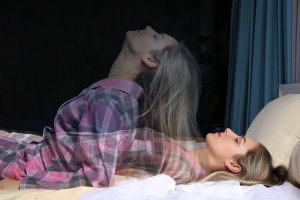Out-of-Body Experiences - What Are They?

Out-of-body experiences encompass several phenomena that are as fantastic as they’re complex. Imagine yourself floating out of your body; this is exactly how it feels. For a long time, the explanations were tribal and mystical. However, now we know it’s all in our brains.
Moreover, out-of-body experiences are perceptual phenomena that include experiences of illusory movement. Among them, we can highlight flying, falling, floating, and seeing ourselves from outside. These dissociative experiences are related to neurological and psychological factors and can occur both in healthy and unhealthy people.
Types of out-of-body experiences
We can divide this phenomenon into two types of experiences with well-defined characteristics:
- Sensory experiences. The sensations of falling or floating are due to a break in the union of the bodily sensations that are related to the vestibular system.
- Autoscopic experiences. These experiences consist of perceiving one’s own body from an outsider’s perspective.
Why do we have out-of-body experiences?

Out-of-body experiences are often associated with altered states of consciousness. Thus, many authors compare the phenomenon with characteristic states of highly imaginative dreams. In addition, it’s a process of an anomalous multisensory integration in which a person is aware of the situation. It’s for this reason that the vestibular, motor, and sensory systems are essential for pregnancy.
“Send these images of me through the Internet out into the universe, where I’ll continue my out-of-body existence.”
-David Cronenberg-
Systems involved in this phenomenon
- Vestibular. The receptors of this system are in the inner ear and are responsible for maintaining stable images in the retina, which is a fundamental ability to maintain balance.
- Motor. During out-of-body experiences, the brain executes the corresponding movement programs in a dissociative plane even though a person isn’t actually moving.
- Sensory. This is like an engine and it’s located in the parietal lobe. Many authors theorize that an out-of-body experience is just a self-perceived image of your body.
Disorders and phenomena linked to out-of-body experiences
When there are alterations in any of the above systems, the predisposition to experience yourself outside your body increases. Disorders linked to sleep, drug use and brain injuries can create the optimal conditions for these phenomena.
Among the phenomena that happen during sleep, we can highlight the following:
- Hypnagogic and hypnopompic hallucinations. These are vivid and confusing perceptual experiences that occur at the beginning and end of sleep.
- Sleep paralysis. The extremities and the motor of execution desynchronize and alter the body’s multisensory processing. Thus, the self-perception leads to feelings of floating outside your body.
- Lucid dreams. These consist of being conscious while you sleep. A person can, in fact, partially direct a dream sharply and with precise details.
- Rapid eye movement sleep. Daydreaming occurs during this stage because the brain is still active, just like when we’re awake. Thanks to electrophysiological studies, scientists discovered that the three previous situations occur mainly during this sleeping stage.
Is it possible to induce an out of body experience?
For centuries, these experiences were linked to the paranormal. This isn’t strange because our ancestors didn’t have the knowledge to study them. Today, we know this phenomenon is due to a distortion of one’s body image, related to cognitive processes such as memory, self-perception, and imagination.
Out-of-body experiences and fantasy
Just as there’s an organic basis for this experience, some psychological factors are also closely linked to the phenomenon. Personality is the most prominent. Several studies reveal that these experiences are more frequent in subjects with a high degree of fantasy and openness. This relationship shows that experiences are also caused by suggestions and personality characteristics.
Artificial induction
One can also artificially induce this phenomenon. The most effective techniques to do so are:
- Induction of brain frequencies. It’s possible to induce Theta wave activity in the brain through the binaural beats characteristic of the states between sleep and wakefulness.
- Transcranial magnetic stimulation. Through the stimulation of the temporal lobes, just as in the Persinger experiment. The hyperconnectivity that generates between lobes leads to an intrusion of the spatial sense of the “I” in the right hemisphere into the linguistic sense of the “I” in the left hemisphere.
- Direct stimulation. In some experiments, researchers provoked these experiences through direct stimulation of the vestibular and motor cortex.
- Electrical stimulation of the temporoparietal junction. As in the Arzy experiment, the stimulation of this area of large multisensory processing causes self-perception errors.
- Sensory deprivation. Disorientation can cause altered states of consciousness where mental images charge excessive realism if you eliminate all references of space and time.
Out-of-body experiences and meditation

This phenomenon usually occurs in states where brain activity is similar to that during sleep but where a person retains consciousness. Researchers discovered that those who meditate regularly have an easier time achieving such experiences. It’s what they refer to as “astral projection”. Thus, Theta waves usually proliferate in extreme states of relaxation such as meditation.
The involvement of mirror neurons
Authors Jalal and Ramachandran propose that the mirror neuron system is so connected it allows virtual vision in the third person. Mirror neurons simply fire up as soon as we see another person do something and connect with our higher centers to anticipate or mimic it, even if we do so just symbolically. The connection of these neurons with the cerebral cortex and afferent pathways is what leads to the “separation from the body” under conditions of sensory disturbance.
A psychobiological phenomenon
Out-of-body experiences involve nervous and motor systems, cognitive functions, and personality traits. It’s also a phenomenon that, under certain conditions, can also be pathological.
Note that seeking this type of experience isn’t necessarily healthy and can be dangerous as it’s closely associated with psychotic crises.
Because people often associate this phenomenon with the paranormal; they refused to speak about it for many years. They didn’t want to be thought of as mentally unstable. Thus, understanding the true causes of this phenomenon is a great first step in treating it correctly.
This text is provided for informational purposes only and does not replace consultation with a professional. If in doubt, consult your specialist.








